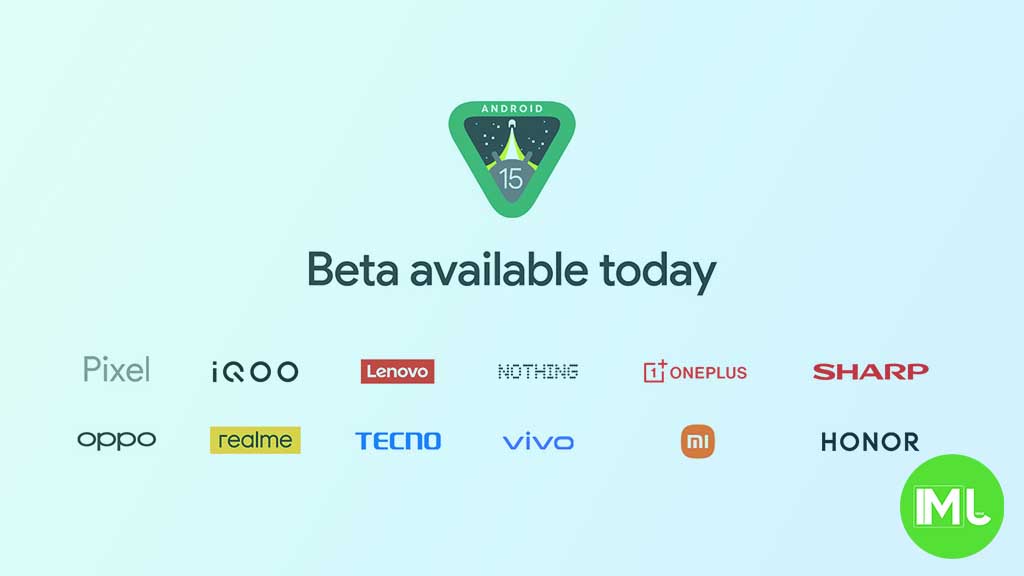Android
Android 15 Beta now available for many non-Google phones

Android 15 Beta Program quit its Pixel exclusivity during Google I/O 2024. While Pixel phones received Beta 2, Google announced Android 15 Beta for select models from iQOO, Lenovo, Nothing, OnePlus, SHARP, OPPO, realme, TECNO, vivo, Xiaomi, and HONOR.
Most of the phone makers use their custom skin based on Android. Hence, consumers may not face visible changes in the user interface due to older custom software versions. As soon as Android 15’s development progresses, vendors will make changes to their corresponding skins.
With Android 15 Beta, eligible smartphone users get improved productivity, minimized battery impact, and maximized smooth app performance. Pixel users also received Private Space, which is a hidden compartment in the Android 15 operating system.
Private Space lets users create a separate space where they can keep sensitive apps away from prying eyes, under an additional layer of authentication. Volume Panel is also redesigned with a fresh new look and added toggles for enhanced user experience.
Android 15 Beta available for –
vivo X100 and iQOO 12
OnePlus 12 and OnePlus Open
Nothing Phone (2a)
Xiaomi 14, Xiaomi 13T Pro, and Xiaomi Pad 6S Pro 12
realme 12 Pro+ 5G
HONOR Magic6 Pro and HONOR Magic V2
TECNO CAMON 30 Pro 5G
Lenovo Tab Extreme
SHARP AQUOS sense8
OPPO Find N3 and OPPO Find X7
Stay up-to-date on Google Pixel, Android & Tech Stuffs by following I M Judge on X/Twitter where you can also discover the latest news, polls, reviews, and new features for Google Apps, Pixel Phones, and the Android operating system.
Do you like this post? Kindly, let us know on X/Twitter: we love hearing your feedback! If you prefer using other social platforms besides X, do follow/join us on Facebook and Telegram.
Android
Android 16 beta adds battery health info, Pixel Fold gets better at detecting opens and closes

Google has released the Android 16 Beta 1 update for Pixel phones, and it brings some helpful new features. One of the key additions is battery health information, which is now available in the settings. Pixel users can now see the battery’s manufacturing date, charge cycles, and overall health score. This can help people understand how well their battery is holding up over time. While this feature is currently hidden under developer options, it might be fully added in a future update.
At the same time, Google is also working to improve the Pixel Fold. With Android 16 Beta 1, there’s a new system that better detects when the phone is opened or closed. This new method uses the hinge angle to more accurately understand the device’s position. Unlike older systems that could be affected by software bugs or slow response times, this new one seems to be more reliable and faster.
These changes are important for people who use foldable phones like the Pixel Fold, as better hinge detection can lead to smoother app transitions and fewer bugs. And for all Pixel users, having detailed battery info can help with managing phone performance and deciding when it’s time for a battery replacement.
Overall, Android 16 Beta 1 focuses on giving users more control and smoother experiences, especially for those with foldables.
Android
Android 16 could bring colorful always-on display to Pixel phones

Google is working on Android 16, and it looks like the update could bring more color to the always-on display (AOD) feature on Pixel phones. Right now, the AOD mostly shows white text on a black screen. But a new setting found in the Android 16 Developer Preview hints at the ability to add colors to this display.
The new feature is called “AOD Preview,” and it includes a switch labeled “Color AOD.” While this setting doesn’t work yet, it suggests that Google might be planning to show colorful content even when the screen is in low-power mode.
This change could make AOD look more lively, maybe by adding color to the clock, notifications, or wallpaper. So far, it’s not clear exactly what will change or how customizable it will be, but the feature seems to be in early testing.
Samsung already has more colorful AOD options on its Galaxy devices, so this update could help Pixel phones catch up. Google often introduces new features first on Pixel devices before making them available to other Android phones.
Android 16 is still being developed, and many features are not ready yet. But if Color AOD becomes part of the final release, Pixel users could get a more vibrant and useful always-on display in the near future.
Android
Android adds quick shortcuts for do not disturb and video call effects

Google is testing two new shortcuts in Android that make it easier to control common features: Do Not Disturb mode and video call effects. These shortcuts are being added to the Android Quick Settings panel, which is the area you see when you swipe down from the top of your screen.
The first new toggle is for Do Not Disturb. Instead of opening the full settings menu, you’ll now be able to tap the shortcut to quickly switch between different DND modes. You can also long-press it to open full options. This makes it easier to silence notifications the way you want, especially if you have custom DND rules set up.
The second toggle is called “Video Effects”. This is useful for people who often use video calling apps like Zoom, Meet, or WhatsApp. When you tap it, it takes you to a page where you can turn on or off features like portrait blur, lighting adjustments, or filters that improve how you look during video calls.
These features are still being tested and might show up in future Android updates. Right now, some Pixel users with Android 14 QPR3 Beta 2.1 have seen these options. Google hasn’t confirmed when they’ll roll out to everyone, but they seem to be part of a plan to make Android tools more convenient.
In short, Google is trying to make it quicker and easier to manage your notifications and video call settings—all with just a swipe and a tap.
-

 Apps1 year ago
Apps1 year agoGboard Proofread feature will support selected text
-

 News1 year ago
News1 year agoSamsung USA crafting One UI 6.1.1
-

 News1 year ago
News1 year agoBreaking: Samsung Galaxy S22 may get Galaxy AI features
-

 News1 year ago
News1 year agoSamsung Galaxy S23 Ultra with One UI 6.1 and all S24 AI features revealed
-

 News1 year ago
News1 year agoOne UI 6.1 Auracast (Bluetooth LE Audio) feature coming to many Samsung phones
-

 News1 year ago
News1 year agoSatellite SOS feature coming to Google Pixel phones, evidence leaked
-

 Apps11 months ago
Apps11 months agoGoogle’s fancy new Weather app is finally available for more Android phones
-

 News1 year ago
News1 year agoGoogle Pixel evolves as Europe’s third best selling flagship






